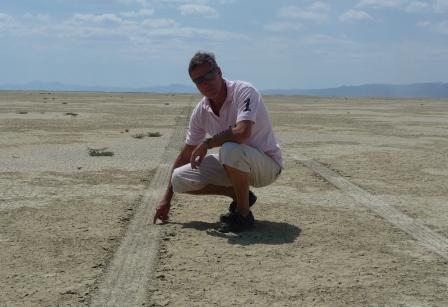
BLOODHOUND circulates a weekly update of activities around the team, so that we can all keep up to speed with this fast-moving programme. In one of July’s updates, Dr Ben Evans described progress in shaping the Car as ‘exciting stuff’. Imagine being the first person in the world to develop a shape that will accelerate from 0 to 1000 mph in less than 50 seconds, and stay on the ground throughout (I’m very keen on this bit) – I’d call that ‘exciting stuff’ too! We’re also working hard to keep everyone on the outside up-to-date with the story as it unfolds. See The Story so far
One of the problems that we have is knowing when we’ve found a shape that is ‘good enough’ to do the job. Should we take the first shape that provides a solution, or keep looking for better, more stable and faster aerodynamic packages? We could keep refining this for years, without ever building anything, which is clearly not the idea. However, if we fix the shape too soon and it’s not quite right, we’ll only find out in 18 months time, when we run it – and the whole world will judge us on the results if we’re wrong. No pressure there, then – but if this was easy, then everyone would be doing it. My guess? I think we are close to a solution that will work. I’ll let you know when the rest of the team agrees with me.
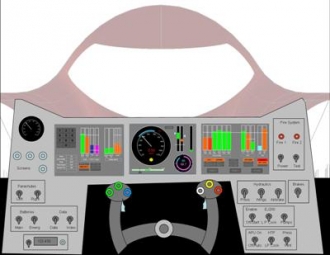 First mock-up of inside the BLOODHOUNDSSC cockpit
First mock-up of inside the BLOODHOUNDSSC cockpit
While it’s too early to design the cockpit yet, we are producing an engineering mock-up, so that we can start testing the control software and systems. This is going to be a complicated car, operating at the limits of technology, and we’re planning on 3 computers to monitor and control jet, rocket, hydraulics, etc. Lots of things to go wrong and lots to test – so this is the safest way to do it.
I’m excited about the mock-up cockpit – it will be the first look at something ‘real’ and will be a great tool for us to develop the final version. It’s also going to be a great way to show people what the Car will be like to drive – a cross between a race car and a space ship!
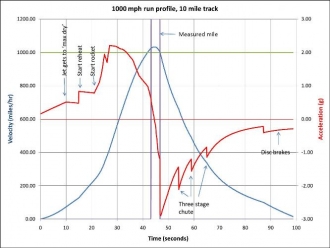 Ron Ayers' velocity and acceleration predictions
Ron Ayers' velocity and acceleration predictions
Another major step forward is in the Car’s software programming. Dr John Davis has managed to recreate Ron Ayers’ performance calculations in the Car’s software programme. This is great news for 2 reasons.
First, it gives an independent check on Ron’s modelling – apparently, this Car really is going to do 1000 mph! Second, it means that the Car can predict acceleration distances, rocket firing points, parachute deployment speeds, etc., which is going to make my life a whole lot easier. 12 years ago, in Thrust SSC, I had to do all these sums in my head. In BLOODHOUND SSC, I’m just not going to have the time.
John Davis is also reconstructing some of the suspension data from Thrust SSC, to give us an idea of how the Car coped with small bumps on the desert surface. Now we just need to choose a desert where we can run BLOODHOUND SSC, and then laser map it so that we can build a suspension to cope.
I’ve just returned from a week in the US, spectating at Bonneville Speed Week (as you can guess from the name, it’s the world’s largest speed meet) and scouting some more deserts for BLOODHOUND. We had a look at Newfoundland Basin (a huge salt pan in Utah, near Bonneville) and Diamond Valley in southern Nevada.
Newfoundland Basin is very hard salt, like Bonneville, which is not the right surface for our metal wheels. It’s also surrounded by soft mud, making it very difficult to get to (we even managed to get stuck on our quadbike – small moment of marital tension ensued, as my wife Emma waded out of the mud….).
Diamond Valley is an alkali (mud) playa, like South Africa, but it’s too soft in places for BLOODHOUND SSC’s 6 tonne mass. [picture top of page]
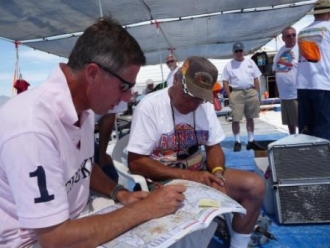 Andy with Ed Shadle from the North American Eagle project
Andy with Ed Shadle from the North American Eagle project
However, it could be used for ‘slow speed’ runs (say up to 600 mph). Our US competition (Ed Shadle) is considering it for some test runs of his jet car, so I gave him all the details of how to get there and what to look for.
Record breaking is a great sport – we can share everything with the competition (and the public, or course), as it won’t make any different to the final result – we’re still going to beat them!
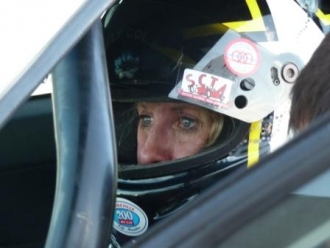 While we were at Bonneville, Emma decided to have a go at land speed racing, to find out what it was all about. Watching her prepare to drive reminded me of how physically hard this sport is – I haven’t driven here for several years and it’s easy to forget. Emma had to struggle into protective clothing (fireproof underwear, a 5-layer fireproof overall, fireproof gloves and boots, a full-face helmet and neck restraint) and was then strapped down with a 5-point race harness and arm restraints into a cramped cockpit in the searing heat (35 degrees C outside, perhaps 50-60 degrees C in the cockpit). [picture right]
While we were at Bonneville, Emma decided to have a go at land speed racing, to find out what it was all about. Watching her prepare to drive reminded me of how physically hard this sport is – I haven’t driven here for several years and it’s easy to forget. Emma had to struggle into protective clothing (fireproof underwear, a 5-layer fireproof overall, fireproof gloves and boots, a full-face helmet and neck restraint) and was then strapped down with a 5-point race harness and arm restraints into a cramped cockpit in the searing heat (35 degrees C outside, perhaps 50-60 degrees C in the cockpit). [picture right]
Unsurprisingly, she was more than a little nervous. It made me think about just how hot and uncomfortable BLOODHOUND is going to be and, being strapped into a Car that will do OVER 1000 MPH, I think I’m going to be a little bit nervous as well.
I’m going to need a lot of physical and mental preparation over the next 12 months or so, to get ready to drive the world’s fastest Car. And now I’ve got to perform – Emma drove flawlessly at Bonneville, completing 3 runs and coming within a few miles per hour of a class record on her last run – so I’ve got no excuses!
Andy Green - August 2009


